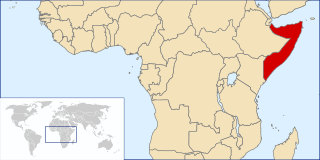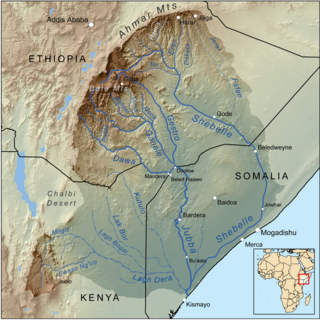
Somalia is a country located in the Horn of Africa which officially consists of six federal member states, namely Galmudug, Hirshabelle, Jubaland, South West, Puntland, Somaliland and the municipality of Benadir.. It is bordered by Ethiopia to the west, Djibouti to the northwest, the Gulf of Aden to the north, the Somali Sea and Guardafui Channel to the east, and Kenya to the southwest. With a land area of 637,657 square kilometers, Somalia's terrain consists mainly of plateaus, plains and highlands. Its coastline is more than 3,333 kilometers in length, the longest of mainland Africa. It has been described as being roughly shaped "like a tilted number seven".

Ethiopia is located in the Horn of Africa. It is bordered by Eritrea to the north, Djibouti and Somalia to the east, Sudan and South Sudan to the west, and Kenya to the south. Ethiopia has a high central plateau that varies from 1,290 to 3,000 m above sea level, with the highest mountain reaching 4,533 m (14,872 ft).

The Jubba River or Juba River is a river in southern Somalia which flows through the autonomous region of Jubaland. It begins at the border with Ethiopia, where the Dawa and Ganale Dorya rivers meet, and flows directly south to the Somali Sea, where it empties at the Goobweyn juncture.

The Shebelle River begins in the highlands of Ethiopia, and then flows southeast into Somalia towards Mogadishu. Near Mogadishu, it turns sharply southwest, where it follows the coast. Below Mogadishu, the river becomes seasonal. During most years, the river dries up near the mouth of the Jubba River, while in seasons of heavy rainfall, the river actually reaches the Jubba and thus the Somali Sea.

Kismayo is a port city in the southern Lower Juba province of Somalia. It is the commercial capital of the autonomous Jubaland region.
The Rer Bare are a tribe in Ethiopia's eastern Ogaden region on the Shabele River, near Somalia, who currently speak Somali. They appear to have shifted to Somali from a now-extinct language.

Jubba Airways is a Somali airline. Previously headquartered at the Aden Adde International Airport in Mogadishu, Somalia, it is now based in Nairobi, Kenya, with additional branches in various other global areas. It operates domestic passenger and cargo flights within Somalia, as well as to destinations in the Middle East.

The Hawiye is a major Somali clan. Members of the clan traditionally inhabit central and southern Somalia, Somali Region and the North Eastern Province. Like many Somalis, Hawiye members trace their paternal ancestry to Irir, the first son of Samaale.
Barre Adan Shire, also known as Barre Hiiraale, Barre "Hirale" Aden Shire, or Abdikadir Adan Shire, is a former Minister of Defense of the Somali Transitional Federal Government (TFG). He was previously the TFG Minister for National Reconstruction and Resettlement. Hiiraale was also the Chairman of the now defunct Juba Valley Alliance, which controlled Southern and Southwestern Somalia, including the nation's third-largest city, the strategic port town of Kismayo. During his time in office, Hiiraale presided over the country's largest autonomous area, as well as commanding an extensive militia.
The Marehan is a Somali clan family, part of the largest Somali clan-family — the Darod. The clan is one of the largest constituent sub-clans of Darod, forming a part of the Sade confederation of clans. The majority of the Marehan live in the Jubaland in southwestern Somalia, as well as the Galguduud and Mudug regions in central Somalia, the Ogaden region of Ethiopia, and the North Eastern Province of Kenya.

Bu'ale is a town in the Middle Juba region of Somalia. It is the capital of the Jubaland State Bu'aale District and the capital of the Jubaland State region as well, situated in the southern Jubba River valley, the city is known for its farming land on the banks of the river Juba. Buale is also the capital of Middle Juba region.
The Shebelle Valley, also spelled Shabeelle Valley, is a valley in the Horn of Africa.
The Juba Valley Alliance is a political faction of the Somali Civil War. It was the primary opponent of the Somali Patriotic Movement (SPM) and the Somali Reconciliation and Restoration Council (SRRC) vying for the control of Kismayo and the Juba River valley, the area known as Jubaland.
Over the course of the Somali Civil War, there have been many revolutionary movements and militia groups run by competing rebel leaders which have held de facto control over vast areas of the country.

Burdhubo is a town in the southern Gedo region of Somalia. It is the center of the Burdhubo District.

Dolow, also spelled Doolow, is a town in the southern Gedo region of Somalia.
The Auliyahan' are a Somali clan, a division of the larger Ogaden clan, living on both sides of the Kenya - Somalia border. There are majorities of the Aulihan clan in Somali Ethiopia regions. The majorities migrated in response to pressure from the expanding Ethiopian empire and had taken control of the hinterland of the lower Jubba river by the 1870s. The Aulihan today hold the middle Jubba Valley areas north of Gelib. Their grazing territory extends across the border into Kenya, and they claim a large part of northeastern Garissa District. They are active in the cross-border cattle trade. In 1984 there was little rain. In search of grazing, Aulihan from Garissa District pushed into Isiolo District where they started to push the Boran people from their pasturage and to raid their herds.

Slavery in Somalia existed as a part of the Arab slave trade. To meet the demand for menial labor, Bantus from southeastern Africa captured by Somali slave traders were sold in cumulatively large numbers over the centuries to customers in Somalia and other areas in Northeast Africa and Asia. People captured locally during wars and raids were also sometimes enslaved by Somalis mostly of Oromo and Nilotic origin. However, the perception, capture, treatment and duties of both groups of slaves differed markedly, with Oromo favored because Oromo subjects were not viewed as racially jareer by their Somali captors.

Jubaland, the Juba Valley or Azania, is an autonomous region in southern Somalia. Its eastern border lies 40–60 km east of the Jubba River, stretching from Gedo to the Indian Ocean, while its western side flanks the North Eastern Province in Kenya, which was carved out of Jubaland during the colonial period.

The Somali Acacia-Commiphora bushlands and thickets is a semi-arid tropical grasslands, savannas, and shrublands ecoregion in the Horn of Africa. It is home to diverse communities of plants and animals, including several endemic species.











